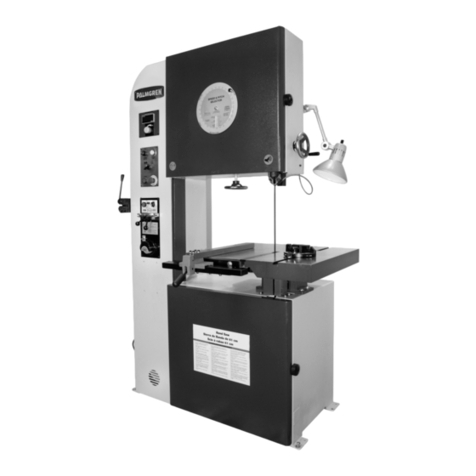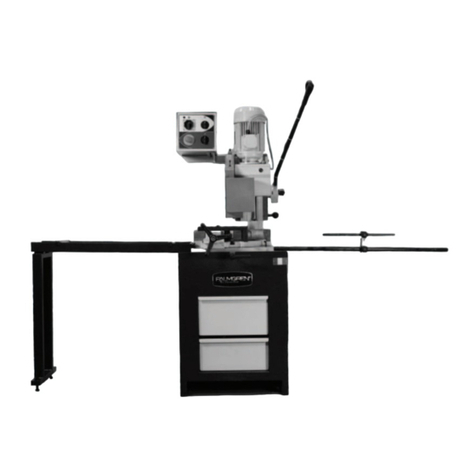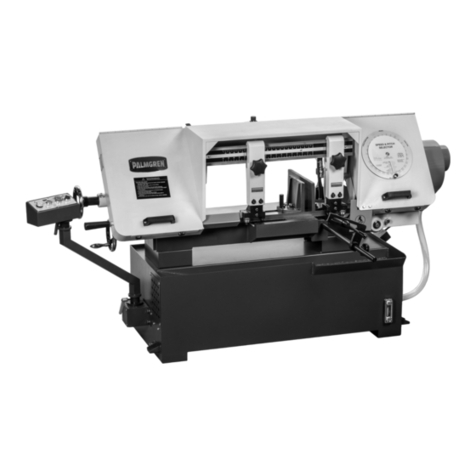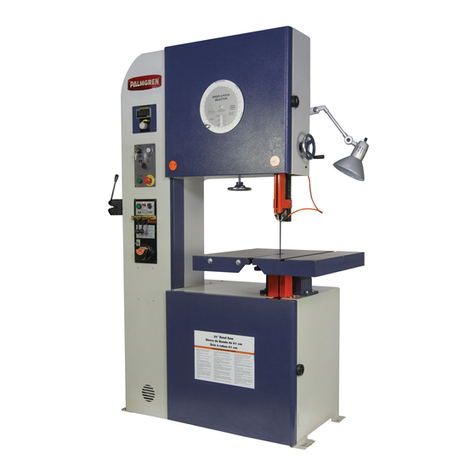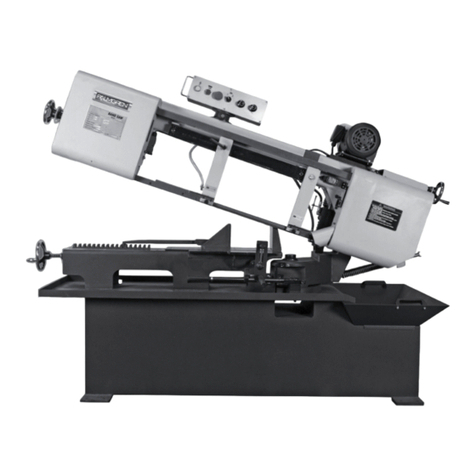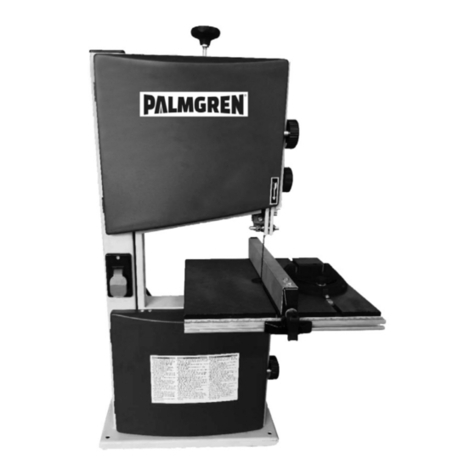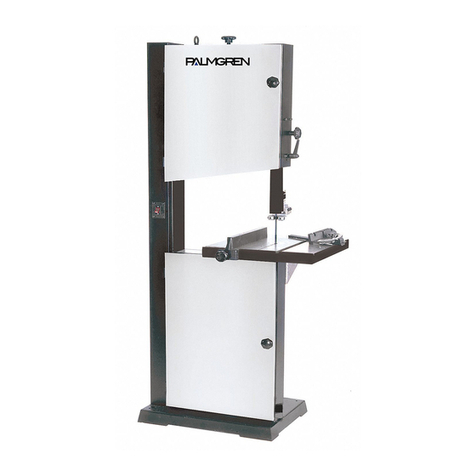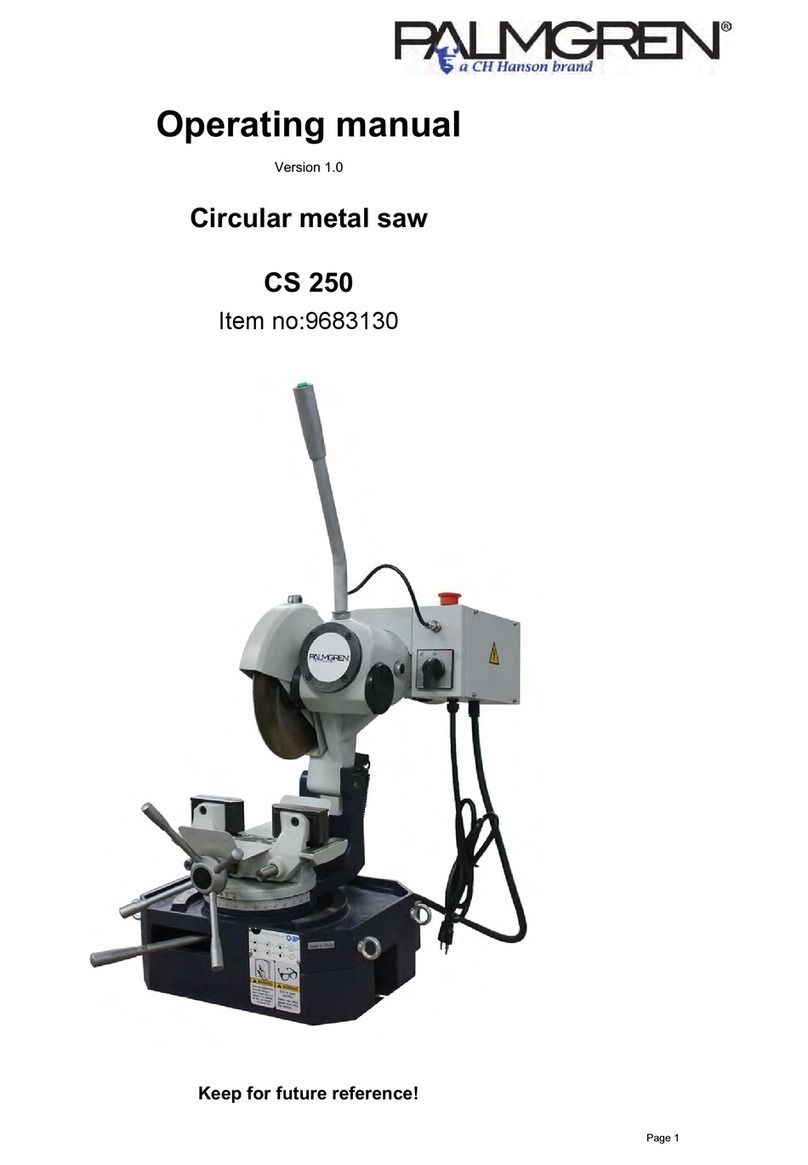
DESCRIPTION
9 x 16” Horizontal Metal Cutting Band Saw provides speed with
quality of cut for fabrication shops, machine shops, mainte nance
departments and contractors. Blade speed ranges from 82 to 235
FPM to cut a variety of material ranging from cast iron, tool steel,
bronze, aluminum and plastic.
The feed rate is regulated by a hydraulic cylinder. The dial control for
the cylinder is accessible during all stages of proper operation and
can be set at any feed rate within its range. The wet cut operation
provides a quality cut and extends blade life. Features include auto -
matic shutoff, industrial rated speed reducer, heavy gauge steel
construction, cast iron wheels, pulleys and bed.
Additional features include swivel vise jaws for angle cuts, built in
chip tray and flange mounting brackets for securing saw to floor.
Saw is controlled by push button magnetic switch with safety off
button.
UNPACKING
Check for shipping damage. If damage has occurred, a claim must be
filed with carrier immediately. Check for completeness. Immediately
report missing parts to dealer.
The band saw comes completely assembled as one unit. Additional
parts which need to be fastened to the saw should be located and
accounted for before assembling:
V-Belt Motor assembly, pulley cover, electrical control box and work
stop assembly.
NOTE: Work stop assembly is located in coolant reservoir under chip
tray.
WARNING: Be careful not to touch overhead power lines, piping,
lighting, etc. if lifting equipment is used. Band saw weighs
approximately 625 lbs. Proper tools, equipment and qualified
personnel should be employed in all phases of unpacking and
installation.
IM ORTANT: Bed is coated with a protectant. To ensure proper fit
and operation, remove coating. Coating is easily removed with mild
solvents, such as mineral spirits, and a soft cloth. Avoid getting clean -
ing solution on paint or any of the rubber or plastic parts. Solvents
may deteriorate these finishes. Use soap and water on paint, plastic
or rubber components. After cleaning, cover all exposed surfaces
with a light coating of oil. Paste wax is recommended for bed top.
WARNING: Never use highly volatile solvents. Non-flammable
solvents are recommended to avoid possible fire hazard.
SPECIFICATIONS
Capacity . . . . . . . . . . . . . . . . . . . . . . . . . . . . . . . . . . . . . . . . . 9” Rounds at 90°
6
1
⁄2” Rounds at 45°
2 x 16” Rectangle at 90°
9 x 14” Rectangle at 90°
9 x 6
1
⁄2” Rectangle at 45°
Motor . . . . . . . . . . . . . . . . . 1
1
⁄2HP, 1720 RPM, 120/240 Volts, 16/8 Amps
Blade speeds . . . . . . . . . . . . . . . . . . . . . . . . . . . . 82, 132, 170 and 235 FPM
Blade size . . . . . . . . . . . . . . . . . . . . . . . . . . . . . . . . . . . . . . . . 1 x .035 x 119
1
⁄2”
Blade wheels . . . . . . . . . . . . . . . . . . . . . . . . . . . . . . . 13” Diameter cast iron
Overall dimensions . . . . . . . . . . . . . . . . . . . . . . . . . . . . . . . . . 67 x 23 x 43
1
⁄2”
Weight . . . . . . . . . . . . . . . . . . . . . . . . . . . . . . . . . . . . . . . . . . . . . . . . . . . . 625 lbs
Coolant pump . . . . . . . . . . . . . . . . . . . . . . . . . . . . 2.25 allons per minute
Coolant reservoir capacity . . . . . . . . . . . . . . . . . . . . . . . . . . . . . . 4.4 allons
GENERAL SAFETY INFORMATION
WARNING: For your own safety, read all of the instructions and
precautions before operating tool.
RO OSITION 65 WARNING: Some dust created by using power
tools contain chemicals known to the state of California to cause
cancer, birth defects or other reproductive harm.
Some examples of these chemicals are:
• Lead from lead-based paints.
• Crystalline silica from bricks and cement and other masonry
products.
• Arsenic and chromium from chemically treated lumber.
WARNING: Your risk from these exposures vary, depending on how
often you do this type of work. To reduce your exposure to these
chemicals: work in a well ventilated area and work with approved
safety equipment. Always wear OSHA/NIOSH approved, properly
fitting face mask or respirator when using such tools.
CAUTION: Always follow proper operating procedures as defined
in this manual — even if you are familiar with use of this or similar
tools. Remember that being careless for even a fraction of a second
can result in severe personal injury.
BE RE ARED FOR JOB
• Wear proper apparel. Do not wear loose clothing, gloves,
neckties, rings, bracelets or other jewelry which may get caught
in moving parts of machine.
• Wear protective hair covering to contain long hair.
• Wear safety shoes with non-slip soles.
• Wear safety glasses complying with United States ANSI Z87.1.
Everyday glasses have only impact resistant lenses. They are
NOT safety glasses.
• Wear face mask or dust mask if operation is dusty.
• Be alert and think clearly. Never operate power tools when tired,
intoxicated or when taking medications that cause drowsiness.
RE ARE WORK AREA FOR JOB
• Keep work area clean. Cluttered work areas invite accidents.
• Do not use power tools in dangerous environments. Do not use
power tools in damp or wet locations. Do not expose power tools
to rain.
• Work area should be properly lighted.
• Proper electrical receptacle should be available for tool. Plug
120/240 volt, single-phase plug directly into properly grounded,
three-prong receptacle.
• Extension cords should have a grounding prong and the three
wires of the extension cord should be of the correct gauge.
• Keep visitors at a safe distance from work area.
• Keep children out of workplace. Make workshop childproof. Use
padlocks or master switches to prevent any unintentional use of
power tools.
2
Palmgren Operating Manual & Parts List 9683314
